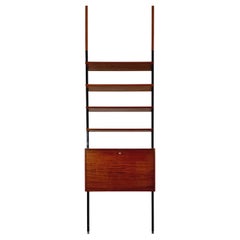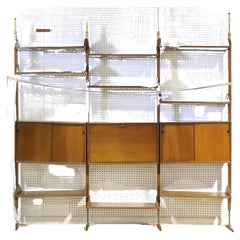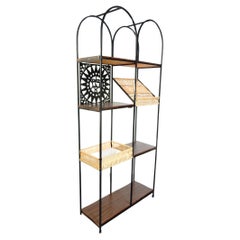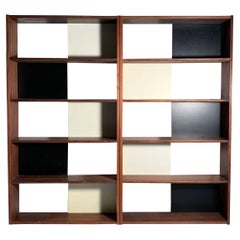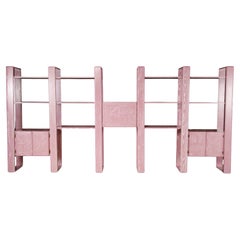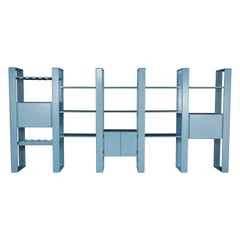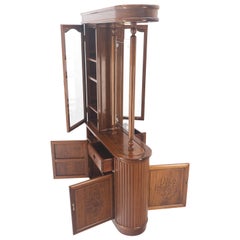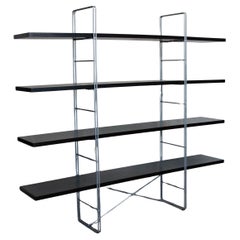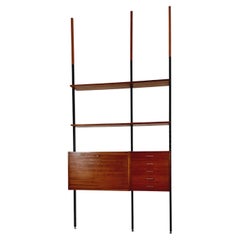Midcentury Modern Bookcase Room Divider
Vintage 1960s Danish Mid-Century Modern Bookcases
Metal
Mid-20th Century Mid-Century Modern Bookcases
Walnut
Mid-20th Century American Mid-Century Modern Bookcases
Metal
Mid-20th Century American Mid-Century Modern Bookcases
Wood
Vintage 1970s American Modern Bookcases
Oak
Vintage 1970s American Modern Bookcases
Oak
20th Century Unknown Mid-Century Modern Bookcases
Teak
Vintage 1980s Bookcases
Metal
Vintage 1960s Danish Mid-Century Modern Shelves
Teak
Vintage 1970s American Modern Bookcases
Oak
Vintage 1970s American Modern Bookcases
Oak
Vintage 1960s Danish Mid-Century Modern Bookcases
Teak
Vintage 1950s American Mid-Century Modern Bookcases
Wood
Vintage 1970s American Modern Bookcases
Oak
Mid-20th Century Mid-Century Modern Bookcases
Wood
Vintage 1960s Mid-Century Modern Screens and Room Dividers
Bamboo
Vintage 1950s American Mid-Century Modern Bookcases
Brass
Vintage 1950s American Mid-Century Modern Bookcases
Walnut
Vintage 1960s Danish Mid-Century Modern Bookcases
Teak
Vintage 1960s Danish Mid-Century Modern Bookcases
Metal
Vintage 1950s American Mid-Century Modern Screens and Room Dividers
Walnut
Vintage 1950s Danish Mid-Century Modern Bookcases
Teak
Vintage 1950s Danish Mid-Century Modern Bookcases
Teak
Vintage 1970s American Mid-Century Modern Bookcases
Aluminum
Mid-20th Century Indian Mid-Century Modern Bookcases
Wood, Teak
Vintage 1950s Italian Mid-Century Modern Screens and Room Dividers
Brass
Mid-20th Century Indian Mid-Century Modern Bookcases
Teak
Vintage 1960s Indian Mid-Century Modern Bookcases
Aluminum
Vintage 1960s Indian Mid-Century Modern Bookcases
Teak
Vintage 1960s Danish Mid-Century Modern Bookcases
Pine
Vintage 1950s Italian Mid-Century Modern Bookcases
Brass
Vintage 1960s Italian Mid-Century Modern Bookcases
Steel
Vintage 1960s Italian Mid-Century Modern Bookcases
Steel
Vintage 1960s French Mid-Century Modern Bookcases
Wood
21st Century and Contemporary Italian Mid-Century Modern Bookcases
Wood
Vintage 1960s Italian Mid-Century Modern Bookcases
Steel
Vintage 1980s French Mid-Century Modern Bookcases
Glass, Wood
Late 20th Century Mid-Century Modern Bookcases
Metal
2010s Italian Mid-Century Modern Bookcases
Wood
Vintage 1950s American Mid-Century Modern Bookcases
Walnut
Vintage 1960s Dutch Mid-Century Modern Bookcases
Metal
Mid-20th Century Belgian Mid-Century Modern Bookcases
Walnut
Vintage 1970s Italian Mid-Century Modern Bookcases
Wood
Vintage 1960s Danish Mid-Century Modern Bookcases
Oak
2010s Italian Mid-Century Modern Bookcases
Wood
2010s Italian Mid-Century Modern Bookcases
Wood
2010s Italian Mid-Century Modern Bookcases
Wood
2010s Italian Mid-Century Modern Bookcases
Wood
Vintage 1960s Italian Mid-Century Modern Bookcases
Steel
Vintage 1960s Italian Mid-Century Modern Bookcases
Steel
Vintage 1960s Italian Mid-Century Modern Bookcases
Metal
Vintage 1950s Italian Mid-Century Modern Bookcases
Steel
Vintage 1960s Italian Mid-Century Modern Bookcases
Metal
Vintage 1950s American Mid-Century Modern Bookcases
Elm
Vintage 1960s Italian Mid-Century Modern Bookcases
Steel
Vintage 1950s Italian Mid-Century Modern Bookcases
Natural Fiber, Teak
Vintage 1950s Italian Mid-Century Modern Bookcases
Metal
Vintage 1960s Danish Bookcases
Teak
Vintage 1960s Danish Bookcases
Glass, Teak
Vintage 1970s Mid-Century Modern Screens and Room Dividers
Walnut
- 1
Midcentury Modern Bookcase Room Divider For Sale on 1stDibs
How Much is a Midcentury Modern Bookcase Room Divider?
A Close Look at Mid-century-modern Furniture
Organically shaped, clean-lined and elegantly simple are three terms that well describe vintage mid-century modern furniture. The style, which emerged primarily in the years following World War II, is characterized by pieces that were conceived and made in an energetic, optimistic spirit by creators who believed that good design was an essential part of good living.
ORIGINS OF MID-CENTURY MODERN FURNITURE DESIGN
- Emerged during the mid-20th century
- Informed by European modernism, Bauhaus, International style, Scandinavian modernism and Frank Lloyd Wright’s architecture
- A heyday of innovation in postwar America
- Experimentation with new ideas, new materials and new forms flourished in Scandinavia, Italy, the former Czechoslovakia and elsewhere in Europe
CHARACTERISTICS OF MID-CENTURY MODERN FURNITURE DESIGN
- Simplicity, organic forms, clean lines
- A blend of neutral and bold Pop art colors
- Use of natural and man-made materials — alluring woods such as teak, rosewood and oak; steel, fiberglass and molded plywood
- Light-filled spaces with colorful upholstery
- Glass walls and an emphasis on the outdoors
- Promotion of functionality
MID-CENTURY MODERN FURNITURE DESIGNERS TO KNOW
- Charles and Ray Eames
- Eero Saarinen
- Milo Baughman
- Florence Knoll
- Harry Bertoia
- Isamu Noguchi
- George Nelson
- Danish modernists Hans Wegner and Arne Jacobsen, whose emphasis on natural materials and craftsmanship influenced American designers and vice versa
ICONIC MID-CENTURY MODERN FURNITURE DESIGNS
- Eames lounge chair
- Nelson daybed
- Florence Knoll sofa
- Egg chair
- Womb chair
- Noguchi coffee table
- Barcelona chair
VINTAGE MID-CENTURY MODERN FURNITURE ON 1STDIBS
The mid-century modern era saw leagues of postwar American architects and designers animated by new ideas and new technology. The lean, functionalist International-style architecture of Le Corbusier and Bauhaus eminences Ludwig Mies van der Rohe and Walter Gropius had been promoted in the United States during the 1930s by Philip Johnson and others. New building techniques, such as “post-and-beam” construction, allowed the International-style schemes to be realized on a small scale in open-plan houses with long walls of glass.
Materials developed for wartime use became available for domestic goods and were incorporated into mid-century modern furniture designs. Charles and Ray Eames and Eero Saarinen, who had experimented extensively with molded plywood, eagerly embraced fiberglass for pieces such as the La Chaise and the Womb chair, respectively.
Architect, writer and designer George Nelson created with his team shades for the Bubble lamp using a new translucent polymer skin and, as design director at Herman Miller, recruited the Eameses, Alexander Girard and others for projects at the legendary Michigan furniture manufacturer.
Harry Bertoia and Isamu Noguchi devised chairs and tables built of wire mesh and wire struts. Materials were repurposed too: The Danish-born designer Jens Risom created a line of chairs using surplus parachute straps for webbed seats and backrests.
The Risom lounge chair was among the first pieces of furniture commissioned and produced by celebrated manufacturer Knoll, a chief influencer in the rise of modern design in the United States, thanks to the work of Florence Knoll, the pioneering architect and designer who made the firm a leader in its field. The seating that Knoll created for office spaces — as well as pieces designed by Florence initially for commercial clients — soon became desirable for the home.
As the demand for casual, uncluttered furnishings grew, more mid-century furniture designers caught the spirit.
Classically oriented creators such as Edward Wormley, house designer for Dunbar Inc., offered such pieces as the sinuous Listen to Me chaise; the British expatriate T.H. Robsjohn-Gibbings switched gears, creating items such as the tiered, biomorphic Mesa table. There were Young Turks such as Paul McCobb, who designed holistic groups of sleek, blond wood furniture, and Milo Baughman, who espoused a West Coast aesthetic in minimalist teak dining tables and lushly upholstered chairs and sofas with angular steel frames.
Generations turn over, and mid-century modern remains arguably the most popular style going. As the collection of vintage mid-century modern chairs, dressers, coffee tables and other furniture for the living room, dining room, bedroom and elsewhere on 1stDibs demonstrates, this period saw one of the most delightful and dramatic flowerings of creativity in design history.
Finding the Right Bookcases for You
Whether you proudly shelve your books in regal mahogany or behind glass cabinet doors, an antique bookcase — or perhaps more than one — is essential to creating a cozy nook for any book lover.
As long as curious people have collected stories, we have needed a place to stow them away and preserve them. When auction houses and book dealers proliferated by the late 17th century, the bibliophile was born. And, of course, as with any treasured decorative objects or collectibles, a book lover’s volumes were suddenly worthy of a luxurious display — enter the bookcase.
Americans of means during the 19th century took to amassing art as well as rare books, and bookcases of the era — rife with hand-carved decorative accents and architectural motifs — were ideal for displaying their handsome leather-bound wares.
Although our favorite titles may change over the years, the functionality and beauty of their home within our home is timeless. Even those who don’t covet the perfect home library can benefit from an attractive display case, as bookcases can easily double as charming étagères.
Contemporary and customizable options make it easier for you to find the perfect bookcase for your style and stacks. If you don’t wish to fill your storage piece so that your collection is snug within its confines, incorporate extra space to allow for additional displays and decorative objects. And by introducing a striking dark wood Art Deco bookcase or low-profile mid-century modern design by Paul McCobb into your living room, your signed first editions won’t be the only items making a statement.
Find barrister bookcases, Globe Wernicke bookcases, bookcases with doors and other vintage and antique bookcases on 1stDibs now.
